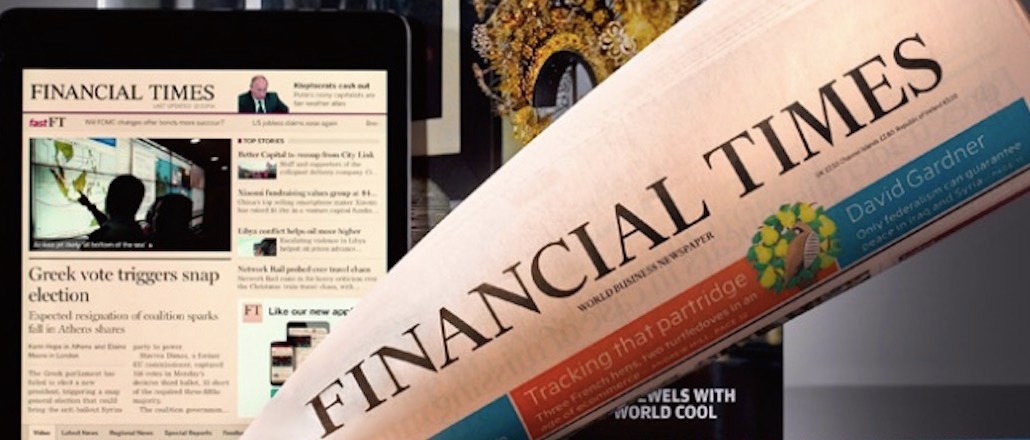
The Financial Times plans to push hard at both ends of the video scale this year, from the 20 minute documentary, to the 50 second Facebook clip.
In October the FT launched the first of its long-form video series, FT Features, a 22-minute documentary on the illegal wildlife trade, “Big Game, Big Money” on YouTube. It’s since had over 325,000 views and is one of the FT’s top ten best performing videos. The second FT Feature, “The End of the Chinese Miracle,” reporting on the economic impacts a shrinking rural workforce has on the country, will land in the next few weeks.
These longer-form videos with deeper analysis are what you would expect from the Financial Times’ content, so it’s of little surprise that it’s making this one of the hallmarks of the brand.
But the FT can’t just play in YouTube, and like other publishers has had to adapt to offer much shorter-form videos. “It’s playing at those two ends, the shorter-form social video and the longer end with more in depth analysis,” said Kayode Josiah, head of commercial development, video and audio. “These are the two ways we can win.”
The FT has a 15-strong video team across the U.K. and U.S., producing up to 200 video clips a month. The team’s most recent addition at the end of last year is a clips editor, who focuses on creating minute-long videos, specifically for Facebook. It’s the FT’s first platform-specific video content creator.
These clips are shorter, have subtitles so can be viewed without the sound, and are getting around five times as many shares as the publisher’s longer videos on Facebook. This 50 second clip on “What’s happening in the South China sea” has been shared nearly 75,000 times. Another format doing well on Facebook is its “Day in fours charts,” with Feb 25 getting 24,000 shares.
Video and podcasts are the only content types available outside the paywall, so need to showcase the FT’s journalism to people who don’t know about it and drive them ultimately to subscribe. There’s a tricky balance to be struck with video on Facebook, as people view it in their feed it’s not as natural a response for them to veer off to the FT.com.
If focusing on the two ends of the scale are two of the FT’s video goals for the next six months, the third is to be able to track conversions. Josiah’s personal target is to have 20 percent of the FT’s video views turn into FT readers over the next few years. “I need to be able to say to you in a year’s time, this Facebook format with these particular end boards saw 20 percent click through rate compared to other formats.”
For this the FT will continue to run numerous tests on things like annotations, font and text, and call to actions at the end of a video. Some videos will work best as introductions to topics, and require further reading, others will be more suited to being shared, and for some it’s fine to just get a Like, according to Josiah.
The FT is in an enviable position — it has 566,000 digital subscribers and digital subscriptions are growing at 12 percent year over year, according to the publisher’s figures, which are audited by Deloitte. There is still no way of monetizing Facebook videos that are uploaded directly to the platform’s player, but because more than half of the FT’s revenue comes from content, is less reliant on ad dollars, which makes monetizing Facebook video less of a concern than for other publishers.
Its short-form social videos offer good introductions to the brand, and the value of the FT’s content has meant that historically people are willing to pay for it.
However, Dan Chapman, Mediacom’s head of digital points out it more competitors are coming to the fore. “With the likes of Max Keiser on RT using YouTube to push out content, there are now rivals to the FT appearing in non-traditional forms, and as such the FT have to make a move to drive adoption. They need to compete with the alternatives, who are producing phenomenal content.”
More in Media

Digiday+ Research: Publishers’ growing focus on video doesn’t translate to social platforms
Major publishers have made recent investments in vertical video, but that shift is not carrying over to social media platforms.

Technology x humanity: A conversation with Dayforce’s Amy Capellanti-Wolf
Capellanti-Wolf shared insight on everything from navigating AI adoption and combating burnout to rethinking talent strategies.

How The Arena Group is rewriting its commercial playbook for the zero-click era
The company is testing AI-powered content recommendation models to keep readers moving through its network of sites and, in doing so, bump up revenue per session – its core performance metric.





